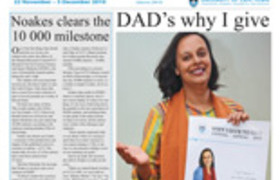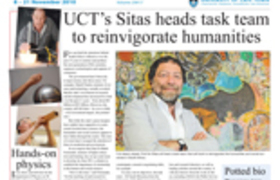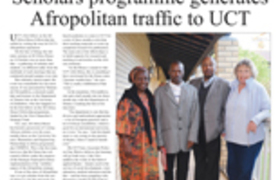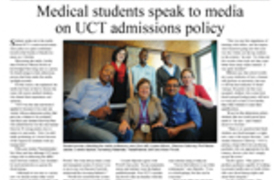Airbus collaboration off to a flying start
06 December 2010 Aiming high: Looking at greener ways to fly are (from left) UCT's Prof Christiaan Redelinghuys and master's students Nicholas Bizinos and Drewan Sanders, with Dale King of Airbus.
Aiming high: Looking at greener ways to fly are (from left) UCT's Prof Christiaan Redelinghuys and master's students Nicholas Bizinos and Drewan Sanders, with Dale King of Airbus.
Birds do it. So well, in fact, that Airbus, the world's leading aircraft manufacturer, has partnered with UCT researchers to see if formation flying could be applied to getting people around in the future.
Out in nature, large birds benefit from co-operative flying to save energy, giving them increased range, explains Professor Christiaan Redelinghuys, head of UCT's Department of Mechanical Engineering, which is undertaking a two-part study. When flying in formation, the leading bird's wings generate trailing vortices (whirling masses) of air, just as fixed-wing aircraft do.
It's the birds flying in the lead bird's wake that benefit most from this, getting a free lift from the vortices, and thus using less energy to fly.
The military have been biomimicking birds for years, and are old hands at formation flying. For obvious reasons (safety, for one) passenger carriers have been less inclined to try out the idea.
But now Airbus is keen to push the envelope and explore, on paper, the potential 'green' application of formation flying.
"Grouping together aircraft flying similar routes, for example from Europe to Africa, could in theory provide a reduction in fuel burn and emissions," says Dale King, senior manager for research and technology partnerships at Airbus.
However, a lot of the finer detail - such as getting passengers comfortable with seeing other aircraft in close proximity through their windows - would still have to be addressed, he points out.
Formation flying, if it ever comes off, is still some way down the line. In the meantime, studies have suggested that energy savings could be as high as 20%, notes Redelinghuys.
"If we could harness those benefits safely, we could reduce the aviation industry's consumption of fossil fuels," he says. "The potential benefits are enormous."
At a press briefing at UCT on 22 November - fittingly hosted by the Percy FitzPatrick Institute of African Ornithology - Airbus unveiled groundwork modelling studies that will be conducted by Redelinghuys and two postgraduate students in his Aeronautical Research Group.
In the first of these, master's student Nicholas Bizinos will look at the effect of formation-flying turbulence on passenger and crew comfort. At the same time, fellow master's student Drewan Sanders will investigate the effect of turbulence on fuel consumption in formation flight.
Both students will be supported by Airbus and South Africa's National Aerospace Centre, based at the University of the Witwatersrand.
The collaboration is but the latest in a string of South African projects sponsored by Airbus, the aim of which is to draw on expertise and ideas from around the globe.
 This work is licensed under a Creative Commons Attribution-NoDerivatives 4.0 International License.
This work is licensed under a Creative Commons Attribution-NoDerivatives 4.0 International License.
Please view the republishing articles page for more information.
Special Projects
News
Ad Hominem Promotions
Front page
Previous Editions










